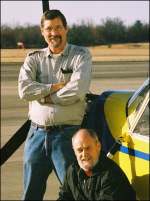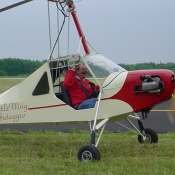LW-5's altitude/time-to-climb flight.
by Andy Keech.
06/22/2004.
 Having achieved the long distance record in Woodstock, I was now very interested in testing how high she could fly. She had proved herself as a reliable, long range and endurance aircraft, and while I had previously flown her to 10,000 ft. on several occasions, and once to 17,500 ft. I had not had the chance to run her up to absolute altitude. I knew that in order to do this she had to be stripped of all but essentials and pared down from her long range 610 lbs empty weight.
Having achieved the long distance record in Woodstock, I was now very interested in testing how high she could fly. She had proved herself as a reliable, long range and endurance aircraft, and while I had previously flown her to 10,000 ft. on several occasions, and once to 17,500 ft. I had not had the chance to run her up to absolute altitude. I knew that in order to do this she had to be stripped of all but essentials and pared down from her long range 610 lbs empty weight.
Ron Herron again proved indispensable in this task. We removed the long range tanks, substituted lighter, longer blades, and even replaced the seat cushion, finally realizing an empty weight of 555 lbs. The only additional weight I had to add was a 5 lb oxygen system.
Communications was my next consideration. Woodstock has a simple radio that has access only to 2 frequencies while in flight. While this had not been a problem on the previous flights, I needed to communicate on 4 frequencies on this one. However I was able to negotiate with helpful an air traffic control who, despite the intense traffic in the Washington DC area, agreed to help me by keeping it to 2 frequencies.
These negotiations delayed my flight well into Spring. I then had to deal with the drawbacks of flying in warmer temperatures: diminished power, oil cooling aspects, and personal discomfort due to being overdressed at ground level. I knew that perspiration in the inner layers of clothing at ground level would destroy the insulation at altitude.
In the initial test flight, Woodstock showed an impressive climb of over 1,300 ft./minute. This was despite using reduced power as high pitch precluded full-boost in the initial climb.The attitude was extreme and a little unnerving to me, a straight and level pilot. However, with a little practice, I became used to the steep attitude and the view of severe blue.
The flight also showed that the very well-sealed and insulated cabin, that had previously served so well, had one obvious drawback at altitude. Condensation began to form on the inside of the cabin windows, and I knew that it would turn to frost above the freezing level. So we had to remove the seals around the door to allow the passage of air through the cabin, just enough to ensure the removal of exhaled, moist air.
I made a few rehearsals to ensure that everything would run smoothly. Just as well because on one of these, I found there had been a slow leak in the oxygen system, and that the radio did not work!
I had to abort the record attempt twice, once because of weather, and again because a security cap was placed over Camp David and the surrounding airspace. Finally, on a marginally passable day, I was able to get off the ground.
At 5,000 ft. I announced my call sign, location and altitude, entered the designated discrete code into the transponder and waited. There was no flashing light on my unit and it dawned on me, "If all else fails, turn it on." I turned the power on and waited. Still no light. The controller came back to me to say that he could not read my target. Crestfallen, I cancelled my flight plan, and advised that I was descending. A few seconds later, the function light began to blink! The controller could see me again, and to my relief, was one who could suffer fools. He generously cleared me to continue the climb.
At about 15,000 ft. he advised me to transfer to the high altitude frequency. When announced, I turned on the oxygen flow and attached an oxymeter to my finger to monitor my blood oxygen level.
At 20,000 ft. my climb rate had dropped to about 500 ft./min and in the increasingly thinner air the propellor and engine began to speed up. I had to reduce the throttle in order to stay under the redline, and found myself fully occupied monitoring engine and rotor function, airspeed, location, and making corrections to keep me there.
In addition, I noticed there was condensation on the inside of the oxygen mask, my glasses and the radio mouthpiece. The headset also seemed wet and began to slide off my ears. So I was busy for awhile handling this. When I looked next I noticed that the GPS indicated 26,000 ft. That was the height to which I was assigned on my flight plan! I could see that Woodstock was still indicating a climb rate of 200-300 ft./min and that I could go even higher and push the record.
I waited for a break in the controller conversations to request permission to descend while noticing that the altitude now read 26,200 ft. In the course of this conversation I inadvertantly allowed the airspeed to drop to zero and as the aircraft began to mush the nose dropped of its own accord and airspeed was quickly regained.. I was surprised how little alarm this caused. Distractions were becoming significant so it was time to head on back down to the airport.
On the ground we checked that the flight took 70 minutes and used 7 gallons of fuel. While monitoring the frequency and chatter, the NAA witness heard a voice which questioned, "That little guy is way up here!?!"
Woodstock had done it again. Weighing a shade over 550 lbs, a quarter the weight of our Volkswagen, she was made to climb. I have a feeling that she would like to poke round up there again to see how far she can really go.
Tne NAA (National Aeronautics Assiciation) witness took the flight recorder to download and submit the results for acceptance by the FAI. The World records claimed were:
- Altitude: 26,408 ft.
- Time to climb to 6,000 meters: 24:28 minutes
The previous records were held by:
- Igor Bensen
2217 m/7273.6 ft.
05/15/1967 - Wing Cmdr. Ken Wallace
5643 m/ 18513 ft.
07/20/1982 - Dr. Bill Clem.
7456 m/24461 ft.
04/17/1998
Andy also has a pending claim for the Time-to-Climb record (pending ratification) with the Fédération Aéronautique Internationale.
